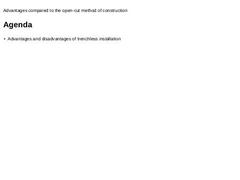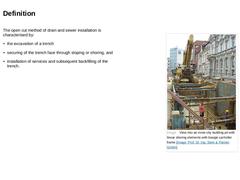
|

|

|

|
(Image: Pros and cons)
Advantages of Trenchless Construction: -
Groundwater lowering is not necessary
-
Relatively small volume of excavated soil
-
Only road breaking is necessary at the starting and target pits
-
Low impact on traffic, resulting in fewer traffic jams and less strain on residents due to exhaust fumes
-
Less damage to neighboring structures
|
(Image: Pros and cons)
Disadvantage of Trenchless Technology: -
Potentially higher costs due to
|
|

|

|

|

This presentation is part of the series of presentations "Utility Tunnelling" and intends to give an extensive introduction to the topic of trenchless technologies. |

|
The open cut method of pipeline installation is characterised by: -
The excavation of a trench,
-
The securing of the trench in the form of a slope or shoring,
-
The installation of the pipeline, and
-
The subsequent backfilling of the trench.
(Image: View into an inner-city building pit with linear shoring elements with boogie car/roller frame) |

|
(Image: Example of subsoil risks) The planning stage requires information regarding the projected construction and the local boundary conditions. It appeared in practice that especially the following criteria are to be considered: -
Type and condition of the subsoil
-
Groundwater conditions
-
Pipe run and depth
-
Material and dimensions of the pipes to be installed
-
Securing of adjacent structures above- and below ground (spacing, depth of foundation, …
|

|
Information on the subsoil and its characteristics (soil parameters) as well as on groundwater conditions is required for the: -
Selection and structural calculation of the excavation support system (temporary sheeting, shoring, and bracing systems)
-
Selection and hydraulic calculation of groundwater retention measures (dewatering)
-
Selection and structural calculation of the pipes
-
Planning of measures for non-load-bearing or unstable subsoil
-
Specification …
|

|
The subsoil conditions either have to be known or need to be investigated. Methods for geotechnical investigation are: -
Aerial photographs
-
Direct explorations
-
Given and examinable explorations
-
Trial pits
-
Borings
-
Indirect explorations
-
Probings
-
Geophysical methods
-
Laboratory tests
-
Soil samples
-
Samples of rock and rock material
-
Water samples
-
Field trials in soil and rock
(Image: Direct explorations – Trial pit) (Image: Direct explorations – … |

|
(Image: Subsoil exploration by means of dynamic probing) The number of, and spacing between, the individual subsoil explorations have to be chosen in accordance with the geological conditions and the engineering needs, and should normally be between 165 ft and 655 ft (50 m and 200 m). The depth of the explorations has to include all soil strata that might be influenced by the structure, and has to extend to at least 7 ft (2 m) below the trench base. |

|
|

|
The extent of the assessment regarding the degree of aggressivity of different types of water, soil and gas is significantly influenced by the pipe material. Examples for the requirements for the evaluation of the corrosion probability of metallic material can be found in [ [DIN50929-3]]. Cement-bound material can be detrimentally affected by different types of water and soil, if these contain the following components: -
Free acids,
-
Sulphides,
-
Sulphates,
|

|
Planning and execution of utility trench construction should follow the rules and regulations shown in the table below. |
Planning / “Theory” |
Execution / “Practice” |
|---|
|
STANDARDS / REGULATIONS: ATV DVWK *ATV DVWK – A 127 *EN 1295 *Material standards |
>>> |
Structural Calculation |
>>> |
*CONSTRUCTION *Occupational health & safety regulations |
|
SITE-SPECIFIC LIMITING CONDITIONS |
>>> |
|
STANDARDS /
REGULATIONS: *EN 1610 *DWA – A 139 *DIN 4124 *VOB |
>>> |
|
OTHER PROVISIONS: |
|

|
As a part of the execution planning, a detailed design of the sewer lines and structures is prepared, and includes the following components: -
Survey maps that show the position of the entire construction measure (scale min. 1:5,000)
-
Layouts (scale min. 1:1,000 / in urban areas min. 1:250)
-
Longitudinal sections/gradient diagrams (scale min. 1:1,000 for the lengths and min. 1:100 for the heights, inclusive of information on subsoil explorations and …
|

|
(Image: Installation of gas- and water supply lines and sewer in a trench - Image 2) If there are several pipes (e.g. supply- and disposal piping) installed in one trench, the required material- and system-dependent minimum distances have to be kept. |

|
The following information includes some of the details required by, and for, the successful execution of work: -
Location of the construction site
-
Ambient conditions
-
Access possibilites, condition of the access road as well as any limitations in its use
-
Already existing, or in close vicinity existing supply- and disposal piping
-
Disposal route (re-use or elimination) for debris and excavated soil
-
Special stipulations for the protection of residents …
|

|
Where required, the limiting values for deviations from the determined lateral and vertical position of the pipe are to be specified. They depend primarily on the following factors: -
Hydraulics
-
Drainage method
-
Pipe run (position and gradient)
-
Construction method
-
Dimensional accuracy of the pipes
-
Operation and maintenance of the sewer network
|

|
It is important to note that the materials used in the construction process should not negatively affect the structural components or the groundwater and soil. |

|
|

|
There has to be a contractual settlement between the client and the contractor with respect to the following items on the agenda: -
Coordination of the work
-
Site equipment
-
Securing the construction site
-
Securing of evidence at/on buildings, structures, roads and other constructions in the zone of influence of the construction site (where required)
-
Avoiding environmental harm
-
Maintaining traffic road safety
-
Securing of drainage capability
-
Maintaining …
|

|
(Image: Open cut method of construction – Built-up area in the zone of influence of the building pit) Prior to the start of the civil engineering works, the exact position of the structures (buildings, piping, cables etc.) within the construction area of the excavation is to be crosschecked by the contractor. The trench construction process should never result in deformations or settlements of the surrounding structures. It is important to ensure that … |

|
Depending on the individual requirements, the open cut method of construction allows for different cross sections of utility trenches, ranging from the sloped trench to trenches with vertical faces [Stein88d]. Combinations, such as stepped trenches with vertical, sloped or partly sloped trench walls, can also be found. (Image: Cross sections of utility trenches for the installation of sewers by means of the open cut method of contruction in accordance … |

|
Excavations and trenches are to be sloped, lined or secured in any other way in order to ensure that they remain stable during all individual states of construction. All conditions and influences that could have a negative effect on the stability of the excavation walls or trench walls are to be taken into account, particularly the differences in the behavior of non-cohesive and cohesive types of soil. (Image: Unshored trench with … |

|
OSHA defines cohesive soil as "clay (fine grained soil), or soil with a high clay content, which has a cohesive strength. Cohesive soil does not crumble, can be excavated with vertical sideslopes, and is plastic when moist. Cohesive soil is hard to break up when dry, and exhibits significant cohesion when submerged. Cohesive soils include clayey silt, sandy clay, silty clay, clay and organic clay." [[OSHA 29 CFR 1926 Subpart P App A]] Non-cohesive … |

|
(Image: Trench excavation úsing a crawler excavator) During the excavation process, it is necessary to inspect the in-situ soil in order to ensure that it’s properties match the assumptions that have been made in the structural calculations (e.g. by means of soil identification). In case of deviations, it is imperative to inform the construction supervisor or structural engineer. |

|
Existing piping and cables need to be taken into consideration when working in urban locations. In case of doubt, it is recommended to excavate the area in question using hand tools or hydro or vacuum excavation in order to determine the exact position of other services, as their actual position very often deviates from the planning drawings. Located services need be properly secured through suspending, supporting, rerouting etc. measures as specified … |